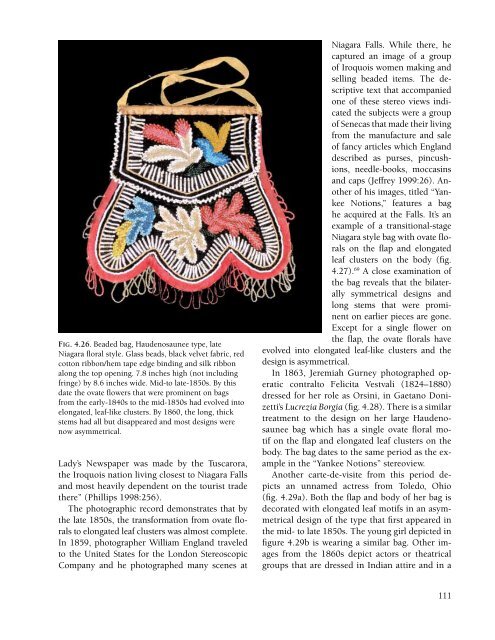A CHERISHED CURIOSITY - GERRY BIRON
A CHERISHED CURIOSITY - GERRY BIRON
A CHERISHED CURIOSITY - GERRY BIRON
You also want an ePaper? Increase the reach of your titles
YUMPU automatically turns print PDFs into web optimized ePapers that Google loves.
fig. 4.26. Beaded bag, Haudenosaunee type, late<br />
Niagara floral style. Glass beads, black velvet fabric, red<br />
cotton ribbon/hem tape edge binding and silk ribbon<br />
along the top opening. 7.8 inches high (not including<br />
fringe) by 8.6 inches wide. Mid-to late-1850s. By this<br />
date the ovate flowers that were prominent on bags<br />
from the early-1840s to the mid-1850s had evolved into<br />
elongated, leaf-like clusters. By 1860, the long, thick<br />
stems had all but disappeared and most designs were<br />
now asymmetrical.<br />
Lady’s Newspaper was made by the Tuscarora,<br />
the Iroquois nation living closest to Niagara Falls<br />
and most heavily dependent on the tourist trade<br />
there” (Phillips 1998:256).<br />
The photographic record demonstrates that by<br />
the late 1850s, the transformation from ovate florals<br />
to elongated leaf clusters was almost complete.<br />
In 1859, photographer William England traveled<br />
to the United States for the London Stereoscopic<br />
Company and he photographed many scenes at<br />
Niagara Falls. While there, he<br />
captured an image of a group<br />
of Iroquois women making and<br />
selling beaded items. The descriptive<br />
text that accompanied<br />
one of these stereo views indicated<br />
the subjects were a group<br />
of Senecas that made their living<br />
from the manufacture and sale<br />
of fancy articles which England<br />
described as purses, pincushions,<br />
needle-books, moccasins<br />
and caps (Jeffrey 1999:26). Another<br />
of his images, titled “Yankee<br />
Notions,” features a bag<br />
he acquired at the Falls. It’s an<br />
example of a transitional-stage<br />
Niagara style bag with ovate florals<br />
on the flap and elongated<br />
leaf clusters on the body (fig.<br />
4.27). 69 A close examination of<br />
the bag reveals that the bilaterally<br />
symmetrical designs and<br />
long stems that were prominent<br />
on earlier pieces are gone.<br />
Except for a single flower on<br />
the flap, the ovate florals have<br />
evolved into elongated leaf-like clusters and the<br />
design is asymmetrical.<br />
In 1863, Jeremiah Gurney photographed operatic<br />
contralto Felicita Vestvali (1824–1880)<br />
dressed for her role as Orsini, in Gaetano Donizetti’s<br />
Lucrezia Borgia (fig. 4.28). There is a similar<br />
treatment to the design on her large Haudenosaunee<br />
bag which has a single ovate floral motif<br />
on the flap and elongated leaf clusters on the<br />
body. The bag dates to the same period as the example<br />
in the “Yankee Notions” stereoview.<br />
Another carte-de-visite from this period depicts<br />
an unnamed actress from Toledo, Ohio<br />
(fig. 4.29a). Both the flap and body of her bag is<br />
decorated with elongated leaf motifs in an asymmetrical<br />
design of the type that first appeared in<br />
the mid- to late 1850s. The young girl depicted in<br />
figure 4.29b is wearing a similar bag. Other images<br />
from the 1860s depict actors or theatrical<br />
groups that are dressed in Indian attire and in a<br />
111


